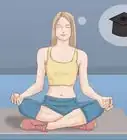This article was co-authored by Andrés Alarcón. Andrés Alarcón is a sahaja yoga practitioner with over 26 years of sahaja yoga training experience. Andrés has traveled to more than 30 countries meditating and sharing experiences learned from Guru Shri Mataji Nirmala Devi. He also participates in public and cultural programs free of cost to spread the self-realization experience and the message that we can know ourselves without needing to pay for doing so.
There are 9 references cited in this article, which can be found at the bottom of the page.
wikiHow marks an article as reader-approved once it receives enough positive feedback. This article received 19 testimonials and 100% of readers who voted found it helpful, earning it our reader-approved status.
This article has been viewed 291,877 times.
Sahaja yoga or "spontaneous union with one's self," was created by Shri Mataji Nirmala Devi in 1970 to bring self-realization to the masses through meditation. It enables people to experience the reality of their own energy.[1] This method transforms human awareness through techniques that promote a more moral, united, integrated, and balanced self. Practitioners claim that hundreds of thousands of people in over ninety countries have experienced the transformation of becoming more peaceful and joyous in life through Sahaja yoga.
Steps
Learning the Basics of Sahaja Yoga
-
1Get to know yourself through self-realization. Self-realization is the foundation of Sahaja yoga. It is based on an experience called the “Kundalini awakening,” which can occur within all human beings. After going through the various steps, you should encounter a transformation that makes you a more moral, united, integrated, and balanced person.[2]
- If you successfully accomplish self-realization, you should be able to feel the divine power sweep over your body in the form of a breeze that passes over your hand and head.
- It is believed by its practitioners that this experience has been witnessed by hundreds of thousands of people in over ninety countries worldwide.
-
2Understand the subtle system. The subtle system is made up of nadis and chakras. Nadis, or channels, carry energy throughout the body while chakras, or “wheels,” are the centers of energy located in the body. There are three primary vertical channels of energy and seven major chakras. This system can only be activated with a Kundalini awakening. The Kundalini awakening simultaneously cleans and balances the system and enlightens and purifies the chakras.[3]
- Each chakra has spiritual abilities. The chakras always exist in the body but they do not manifest their full qualities until the Kundalini is awakened.[4]
- When the Kundalini rises and nourishes the chakras, our bodies automatically become dynamic, creative, confident, and very humble.
Advertisement -
3Know the spiritual abilities of the chakras. Chakras are called wheels because this is where the energy spins with frequency, similar to a galaxy of planets spinning on their axis. Chakras are located along the spinal cord region and supervise and maintain the perfect operation of the bodily system. What attracts and disturbs the chakras influences their sensitivity and performance. Self-realization will enlighten the central nervous system, allowing you to feel each of the seven chakras.[5]
- The mooladhara, or first chakra, will help you rediscover your innocence, and innate and intuitive wisdom.
- The second chakra, or swadisthana, will stimulate your creative instincts and establish pure knowledge.[6]
- At the nabhi, third chakra, the realization of your accomplishments will be satisfied and your inner peace will be established within.[7]
- Your heart will be opened along with compassion for family and friends during the fourth chakra, or anahat.
- Good communication, a sense of perspective, and a balanced approach to stressful situations will be summoned during vishuddhi, or the fifth chakra.
- At the sixth chakra, or agnya, your forgiveness will allow you to move forward with life without grudges or hatred. You will be able to identify with your freedom and power of your inner self.
- Finally, the last chakra, sahasrara, will allow you to have a transformative connection that enables you to understand a deeper and truer meaning and purpose to your life.
-
4Know the channels, or nadis. There are three main nadis: the left channel (Ida Nadi), also called the “moon channel,” is located along the left side of the body and provides the conduit for the energy of our desire. The right channel (Pingala Nadi), or “sun channel,” runs along the right side of the body and is responsible for active energy, as well as our mental and physical activities. The central channel (Sushumna Nadi) is located along the spine to the highest chakra.[8]
- The central channel coordinates the nervous system activities. It is not until the awakening of the Kundalini and its travel through the central channel and out through the top of the head that recognition occurs of the vastness of the subtle system.
- The left channel represents different qualities and aspects such as the expression of our desires and the past. Here one might collect all one's habits and conditionings. If this channel is obstructed or out of balance, you might feel depressed, sad or lazy. Through the practice of Sahaja Yoga, you might be able to remove all the obstacles on this channel so you can be free from the past.[9]
- The right channel is related with the power of action and the future. If this channel is not in balance, it is easily blinded by ego and can change our behavior to be more aggressive and dominating. The Sahaja Yoga meditation can remove this negativity and restore balance between the channels and the chakras.[10]
- Ask the energy to rise through your central channel to give you self-realization.[11]
Experiencing Self-Realization Meditation
-
1Prepare for self-realization. Sahaja yoga provides the conscious awareness of subtle energy found in the body through true meditation. It is a natural awakening that has measurable beneficial effects on the body's well-being without side effects, special exercises, chanting, or mantras. As Sahaja yoga has become more popular around the world, it has proven to be effective in people's lives everywhere, regardless of age, occupation, race, color, or creed.[12]
- Find a comfortable place to sit down with little distraction. During the experience, your left hand will remain on your left lap with your palm facing up.
- You can also sit on a chair or on the floor in a comfortable position, and remove your shoes to have better contact with the earth element.[13]
- Your right palm will be used to touch certain parts of your body on the left side.
- As you make the motions, keep your eyes closed during the entire experience so that you can keep your attention “inside.”
- It is recommended that you take your shoes off since Mother Earth drains all negative energy through the feet.
-
2Perform self-realization meditation. The divine power is easily awaken inside all of us during the performing of Sahaja yoga. During the experience, one can feel the divine vibration in their hands. You will also be able to feel a cool breeze on the top of your hands and head. These “vibrations” are believed to be divine energy so real that it can be captured on film.[14]
- It is believed that an inner energy resides in the sacrum bone known as Kundalini. This energy is like a Mother who remains dormant, waiting patiently to be awakened by an authorized Guru so you can achieve self-realization and become your own master.[15]
- Put your right hand on your heart and then ask the Kundalini inside of you three times: “Mother, am I the spirit?”
- Place your right hand under the ribs on the left-hand side of your body and ask the Kundalini three times: “Mother, am I my own master?”
- After that, place your right hand on your left side just below the belt, gently press and ask the Kundalini inside your body six times: “Mother, please give me the pure knowledge.”
- Then, put your right hand under your left ribs and say ten times: “Mother, I am my own master.”
- Place you right hand over your heart and repeat to the Kundalini twelve times: “Mother, I am the pure spirit.”
- Next, put your right hand between your neck and left shoulder while turning your head towards the right. Repeat sixteen times to the Kundalini: “Mother, I am not guilty at all.”
- While placing your right hand on your forehead, bend your head down and say a few times: “Mother, I forgive everyone including myself.”
- Then, put your right hand on the back of your head, push your head back and say, “Oh, Divine Power, if I have committed any mistakes, please forgive me.”
- Finally, open your hand fully and press on the fontanelle bone area on top your head. Move it slowly clockwise seven times, moving your scalp in unison with your hand. Each time repeat: Mother, please give me my Self-Realization."
-
3Conclude the self-realization meditation. After you completed the meditation, take a moment to absorb your environment and to experience your feelings. By the time you finish, your feelings should be relaxed and your thoughts should have disappeared.[16]
- This is considered the first step of meditation, or “thoughtless awareness,” when you were completely cognizant without thought, in a pure state of peaceful consciousness.
- Now that you have reached this stage, you should feel the sensation of the cool breeze on the top of your hands and head. This is the Kundalini energy purifying the chakras in your body.
- If you fail to experience the breeze, the most likely cause is you did not forgive everybody. Therefore, say “Mother, I forgive everyone” a few times and check for the cool breeze once again.
Reaping the Benefits of Sahaja Yoga
-
1Discover the inner subtle self. Nourishing chakras produces lifelong improvement of your own personal qualities. Consistent Sahaja yoga practice will help you concentrate on which specific chakras need attention and how to develop the specific qualitative aspects associated with each chakra.
- Over time, you will develop into a more spiritual, subtler person with heightened awareness of the important virtues of life.
- As you strengthen the state and condition of your channels and chakras, you will simultaneously recognize how your relationships, creativity, focus, productivity and decision-making ability all improve.
- Taking control over your energy sources and the paths they travel through in your body will allow you to manage ill thoughts and feelings, regulate self-damaging emotions, and feelings of worthlessness. You will be better equipped to problem-solve.
-
2Experience emotional well-being and self-improvement. The inner calm that is part of the Sahaja yoga experience boosts your emotional resilience. This ensures your ability to cope with stress now and in the future. Sahaja yoga also helps to restore balance internally and externally in your life. It helps build self-esteem in relationships and accomplishments, repairs any negative feelings, and brings peace and contentment.
- Kundalini energy extends beyond the meditation period and into your daily life. Thus, you benefit from meditation, yoga, and self-realization.
- Sahaja yoga helps you to self-regulate your attention and concentration on the present. It enhances your openness and curiosity.
- You will quickly realize how you take time to make good decisions by analyzing your thoughts, feelings, and sensations as they occur resulting in increased self-awareness.
- Communication with others will improve as your levels of compassion and empathy increase for yourself and for others. You become more cognizant of the flow of energy in the environment, in your mind, and through the eyes of others.
-
3Enjoy the mental health benefits of Sahaja yoga. Evidence from several clinical and neurobiological studies demonstrate the impact that meditation has on influencing brain chemical activities that regulate attention, mood, and emotions in positive ways. Studies indicate that Sahaja yoga increases positive emotions, reduces negative emotions, improves emotional flexibility and coping skills, and overall psychological stability.
- Cognitive improvements were also found in self-esteem, self-awareness, mindfulness, emotional intelligence, and self-realization.
- Sahaja yoga also relieves anxiety, improves blood pressure,[17] may help manage asthma,[18] and may relieve depression.[19]
- Stress relief is the base-level benefit for Sahaja yoga practitioners and some clinical results have confirmed that belief. It is believed that thoughtless awareness significantly improves the ability to cope with difficult events by reducing stress and boosting positive emotions.
- Sahaja yoga confronts addiction and substance abuse by rewiring the old pleasure-reward-motivation patterns that the brain has learned over a lifetime. This helps eradicate bad habits.
EXPERT TIPSoken Graf is a Meditation Coach, Buddhist Priest, Certified Advanced Rolfer, and a Published Author who runs Bodhi Heart Rolfing and Meditation, a spiritual life coaching business based in New York City, New York. Soken has over 25 years of Buddhist training experience and advises entrepreneurs, business owners, designers, and professionals. He has worked with organizations such as the American Management Association as a consultant for training courses on such topics as Mindful Leadership, Cultivating Awareness, and Understanding Wisdom: The Compassionate Principles of Work-Life Balance. In addition to his work as a priest, Soken has certifications in Advanced Rolfing from the Rolf Institute of Structural Integration, Visceral Manipulation, Craniosacral Therapy, SourcePoint Therapy®, and Cold-Laser Therapy.Certified Meditation Coach
 Soken Graf
Soken Graf
Certified Meditation CoachOur Expert Agrees: Meditation really helps you control your mind. If you can't control your mind, you're purely ruled by your nervous system and your environment, so you're just reacting to things without being able to reflect on them. On the other hand, focus leads to composure, self-empowerment, and autonomy.
Expert Q&A
Did you know you can get expert answers for this article?
Unlock expert answers by supporting wikiHow
-
QuestionHow can sahaja yoga meditation help me?
 Andrés AlarcónAndrés Alarcón is a sahaja yoga practitioner with over 26 years of sahaja yoga training experience. Andrés has traveled to more than 30 countries meditating and sharing experiences learned from Guru Shri Mataji Nirmala Devi. He also participates in public and cultural programs free of cost to spread the self-realization experience and the message that we can know ourselves without needing to pay for doing so.
Andrés AlarcónAndrés Alarcón is a sahaja yoga practitioner with over 26 years of sahaja yoga training experience. Andrés has traveled to more than 30 countries meditating and sharing experiences learned from Guru Shri Mataji Nirmala Devi. He also participates in public and cultural programs free of cost to spread the self-realization experience and the message that we can know ourselves without needing to pay for doing so.
Sahaja Yoga Practitioner
Warnings
- While this is not a religious practice per se, you do need to maintain a level of spirituality when you perform Sahaja yoga. The belief in a supernatural opens your mind to the possibilities of Sahaja yoga.⧼thumbs_response⧽
- When it comes to the human mind, very little is known. While there is a correlation between relaxation and health benefits, there is no direct cause-and effect. Therefore, Sahaja yoga might act as a placebo effect.⧼thumbs_response⧽
References
- ↑ Andrés Alarcón. Sahaja Yoga Practitioner. Expert Interview. 7 July 2020.
- ↑ http://www.sahajayoga.org/
- ↑ http://www.sahajayoga.org/chakrasandsubtlebody/default.asp?mode=text
- ↑ Andrés Alarcón. Sahaja Yoga Practitioner. Expert Interview. 7 July 2020.
- ↑ http://www.sahajayoga.org/chakrasandsubtlebody/default.asp
- ↑ Andrés Alarcón. Sahaja Yoga Practitioner. Expert Interview. 7 July 2020.
- ↑ Andrés Alarcón. Sahaja Yoga Practitioner. Expert Interview. 7 July 2020.
- ↑ http://www.sahajayoga.org/chakrasandsubtlebody/default.asp
- ↑ Andrés Alarcón. Sahaja Yoga Practitioner. Expert Interview. 7 July 2020.
- ↑ Andrés Alarcón. Sahaja Yoga Practitioner. Expert Interview. 7 July 2020.
- ↑ Andrés Alarcón. Sahaja Yoga Practitioner. Expert Interview. 7 July 2020.
- ↑ http://www.sahajayoga.org/chakrasandsubtlebody/default.asp
- ↑ Andrés Alarcón. Sahaja Yoga Practitioner. Expert Interview. 7 July 2020.
- ↑ http://www.sahajayogaportal.org/en/realization/realization-meditation.html
- ↑ Andrés Alarcón. Sahaja Yoga Practitioner. Expert Interview. 7 July 2020.
- ↑ http://www.sahajayoga.org/ExperienceItNOW/
- ↑ http://www.ncbi.nlm.nih.gov/pubmed/22784346
- ↑ http://www.ncbi.nlm.nih.gov/pubmed/11828038
- ↑ http://www.ncbi.nlm.nih.gov/pubmed/16579401
About This Article
Sahaja yoga is a form of yoga that involves meditation and bringing awareness to different chakras throughout the body. Some people find that Sahaja yoga helps them feel more balanced, peaceful, and confident. To meditate in Sahaja yoga, you'll sit in a comfortable position and touch different parts of your body, like your heart, ribs, and forehead, as you recite mantras. This is believed to help nourish your chakras. Chakras are points of spiritual energy going from your head to the base of your spine. For more tips, including how to do each step of Sahaja yoga meditation, read on!

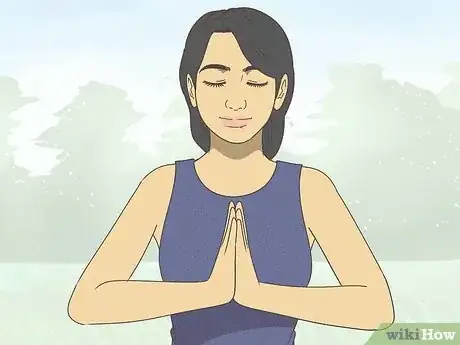
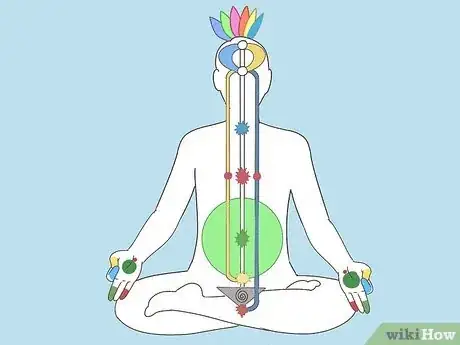
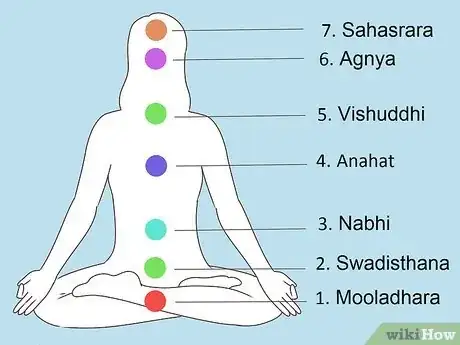
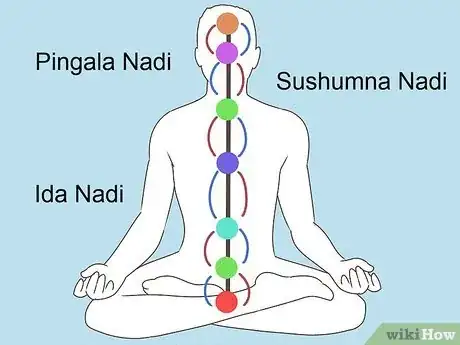
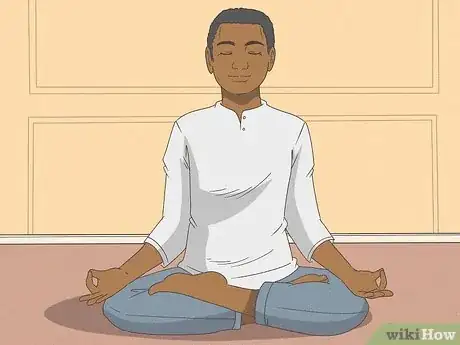
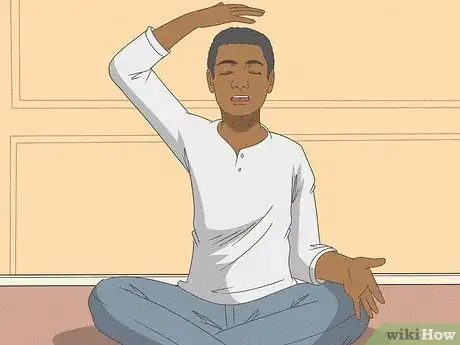

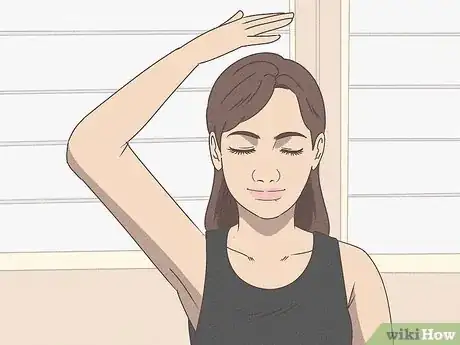
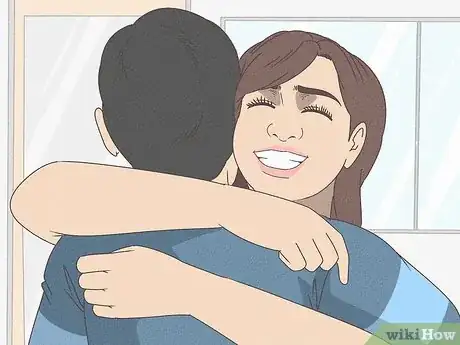
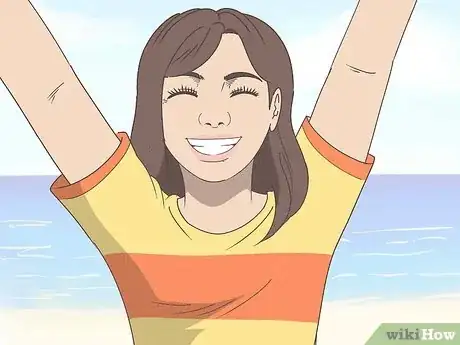
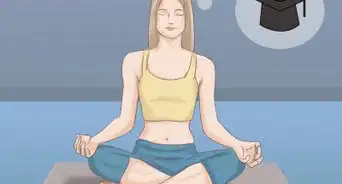


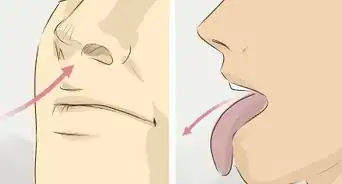
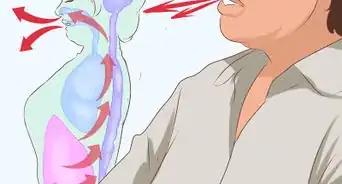



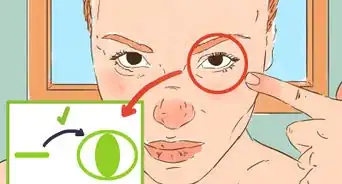

-Step-6-Version-3.webp)











